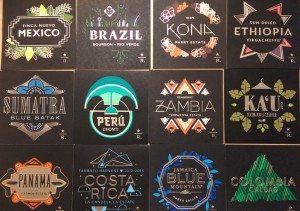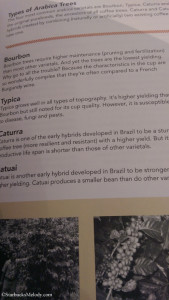 For those who are interested in coffee education, I want to talk about what a coffee varietal is. There are three things that happened (all within a short time of each other) that inspired me to put this article together 1) in my own closed Facebook group, there was a great conversation from a customer asking why certain coffees come around just once a year or so – it lead to some discussion of varietals 2) on one occasion, I watched a barista at a Reserve store tell a customer that a coffee was labeled a “bourbon” because it tastes like rum . When I confronted the barista to try to tell her what “bourbon” was, she admitted to me (and recognizing me) that she had no idea why it was called Brazil Bourbon, so she made a wild guess. (It has nothing to do with alcohol, bourbon, or rum.) and 3) I saw another closed Facebook group where there was a discussion by partners that they wanted more coffee education.
For those who are interested in coffee education, I want to talk about what a coffee varietal is. There are three things that happened (all within a short time of each other) that inspired me to put this article together 1) in my own closed Facebook group, there was a great conversation from a customer asking why certain coffees come around just once a year or so – it lead to some discussion of varietals 2) on one occasion, I watched a barista at a Reserve store tell a customer that a coffee was labeled a “bourbon” because it tastes like rum . When I confronted the barista to try to tell her what “bourbon” was, she admitted to me (and recognizing me) that she had no idea why it was called Brazil Bourbon, so she made a wild guess. (It has nothing to do with alcohol, bourbon, or rum.) and 3) I saw another closed Facebook group where there was a discussion by partners that they wanted more coffee education.
Of course, the huge caveat to this is that I’m not a Starbucks certified coffee master. I sometimes feel like if I worked for Starbucks, I might be, but I’m not.
So what is a varietal?
One thing to kind of keep in the back of your mind is that coffee is a farm product. Just as you might expect Fuji apples to taste different than Golden Delicious, coffee varietals are unique – of course, much of the flavor profile comes from variation in coffee processing too.
When you think of a blend, you might think that if you sold a crate of apples with some Fuji, some Honey Crisp apples, some Golden Delicious – even if they all came from the same country – it’s not one varietal in the bag. They all come from many farms, and might each have slightly different processing or growing micro-climates. A blend like Kenya or Guatemala Antigua is a blend of many farms’ coffee from one country.I suppose it’s possible that Starbucks will produce bags of Guatemala Antigua that are all the same varietal – if they sourced it from many farms who were all growing the same coffee trees, such as Typica or Bourbon.
A multi-country blend, such as Christmas Blend, might have some beans from Indonesia, as well as beans from Latin American farms. By the way, when we use the word “Estate Coffee” that almost always means that the coffee beans were all sourced from one single farm. Sometimes Reserve coffees from a single farm are labeled by the name of the farm – the Spanish word for farm is “Finca.” So I would assume that a “Finca Neuvo” coffee from Mexico came from just one farm.
This also partly explains why some coffees come and go. I would assume that if you’re farming the Maui Mokka coffee, Starbucks comes in and tries to buy your entire harvest. When your harvest is gone, it’s gone … until the next harvest. Multi-farm blends can often be offered year-round because Starbucks doesn’t depend on just one farm to supply those beans. Although this is only a small piece of the story. If there are many farms all sourcing the same varietal, it may be that Starbucks can keep sourcing (and offering) a coffee like a “Yirgacheffe” by working with many different farmers.
If you’re working on becoming a coffee master, go to page 31 of your coffee master workbook. There you’ll find that a varietal is described as “a type of tree.” Just as a Fuji apple tree can’t produce Golden Delicious apples, the Typica coffee tree isn’t going to produce Geisha coffee beans. The Starbucks coffee master book says that the four most common varietals are as follows:
- Bourbon
- Typica
- Caturra
- Catuai
I have to admit that was a surprise to me. I had thought that I had learned in loose conversation that the “Typica” bean is the most common varietal. Still, if I don’t know what the varietal of bean is, I will assume that it’s a Bourbon or Typica.
I definitely think this Wikipedia page which has a list of many varietals is helpful!
You might be wondering, “What do people mean when they talk about heirloom varietals?” – An “heirloom varietal” is a pure varietal that is not a hybrid of other beans. Just as a Honey Crisp apple was developed by hybridization, some coffee varietals are created the same way. I know that a “Geisha” coffee is considered an “heirloom varietal.”
I would agree that sometimes when you look at the front of the coffee cards and try to parse out the meaning of each and every word, sometimes it’s confusing. You might find the name of the farm; you’ll always find the name of the growing country; and you may find the varietal listed.
I know that many partners reading this know all of this – but I’ve definitely met some partners who don’t know much about the types of coffee beans, and what that means. I hope you found this helpful!
Hope you enjoyed this coffee education article!
(As an aside, please don’t forget that if you buy Tales of the Siren during the month of July as a paperback from Amazon, I’ll donate a dollar to the CUP Fund for each book sold.)
Related posts
7 Comments
Leave a Reply Cancel reply
You must be logged in to post a comment.
Sponsors
Recent Comments
- DEVIN on Compostable Straws Land in Seattle Starbucks Stores
- coffeebeanz on Why do you go to Starbucks less often? (If that’s true for you)
- Willi on You can now buy a Siren statue: $6,000
- Willi on A major revamp of your drink recipe: Testing syrup extracts and cane sugar
- Skip on Why do you go to Starbucks less often? (If that’s true for you)







Great information.
What are all of the single origin coffees that Starbucks offers that are *not* Reserve or Seasonal?
@MJM –
Technically, Kenya, Guatemala Antigua, and Sumatra are “single origin” though I’ve even heard this be debated. Basically, since they’re all sourced from one country (but many farms and may be multi-varietal blends), they’re “singe origin.”
All of the Reserve coffees (except Micro Blend 11, and the Kent-Venti Blend) are true single-origin coffees.
I’m pretty sure you call Casi Cielo a “single origin” too since it’s an all Guatemalan coffee. ?
@Melody, I really enjoyed this blog post. It refreshed my memory on some of my forgotten coffee knowledge and provided a few new tidbits.
I really had to chuckle about Bourbon Coffee, I cannot count the times I have heard similar misunderstandings.
@DadCooks – Thanks! Yes, though I think the lesson about the “bourbon” confusion is not that a person doesn’t know – everyone is someone where on their knowledge curve – however, rather than just make a wild guess and say that’s the answer, actually invest your time to find out more information – ask a coffee master, and read online, and work on coffee knowledge. That’s just generally the right answer in my book: don’t make wild guesses, actively seek out good information.
This was a great READ Melody!
@Melody- Guatemala Casi Cielo is actually a single origin coffee, it is a blend of coffees from four farms in the Antigua region.
Also, Ethiopia (Buna) is a single origin and part of the core lineup since last year.
Hi melody, ive been reading your blog for a little over a year now and wanted to tell you i really enjoy it. ive been a coffee fan for a little over a decade now with my interest growing a little more each year. I used to be a big big fan of starbucks like yourself but now i brew at home a lot more. Im not sure if youve ever given this serious thought, but you should try roasting your own coffee beans at home, it will totally change how you see coffee. You will really get to know the different origins and what have a much different experience with coffee. i still buy starbucks drinks from other cafes occasionally, but im usually more looking forward to trying one of varieties ive roasted at home. home roasting is much cheaper and more convenient than it was five years ago.